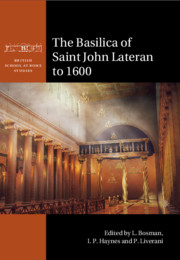Refine search
Actions for selected content:
5894 results in Classical art and architecture
Contributors
-
- Book:
- Skilled Labour and Professionalism in Ancient Greece and Rome
- Published online:
- 18 September 2020
- Print publication:
- 03 September 2020, pp ix-x
-
- Chapter
- Export citation
Index
-
- Book:
- Skilled Labour and Professionalism in Ancient Greece and Rome
- Published online:
- 18 September 2020
- Print publication:
- 03 September 2020, pp 383-394
-
- Chapter
- Export citation
7 - Artists beyond Athens: The Freedoms and Restrictions of the Artistic Profession in Classical Greece
- from Part III - Case Studies of Professions 1: Sculpture
-
-
- Book:
- Skilled Labour and Professionalism in Ancient Greece and Rome
- Published online:
- 18 September 2020
- Print publication:
- 03 September 2020, pp 230-242
-
- Chapter
- Export citation
Part V - Case Studies of Professions 3: A Profession of Arms?
-
- Book:
- Skilled Labour and Professionalism in Ancient Greece and Rome
- Published online:
- 18 September 2020
- Print publication:
- 03 September 2020, pp 333-382
-
- Chapter
- Export citation
Appendix 3 - Appendices
- from 1 - Many Ancient Greek Occupations, but Few Professions
-
- Book:
- Skilled Labour and Professionalism in Ancient Greece and Rome
- Published online:
- 18 September 2020
- Print publication:
- 03 September 2020, pp 57-57
-
- Chapter
- Export citation
Part IV - Case Studies of Professions 2: Music and Athletics
-
- Book:
- Skilled Labour and Professionalism in Ancient Greece and Rome
- Published online:
- 18 September 2020
- Print publication:
- 03 September 2020, pp 267-332
-
- Chapter
- Export citation
6 - Professionalism in Archaic and Classical Sculpture in Athens: The Price of Technē
- from Part III - Case Studies of Professions 1: Sculpture
-
-
- Book:
- Skilled Labour and Professionalism in Ancient Greece and Rome
- Published online:
- 18 September 2020
- Print publication:
- 03 September 2020, pp 205-229
-
- Chapter
- Export citation
Copyright page
-
- Book:
- Skilled Labour and Professionalism in Ancient Greece and Rome
- Published online:
- 18 September 2020
- Print publication:
- 03 September 2020, pp iv-iv
-
- Chapter
- Export citation

The Basilica of Saint John Lateran to 1600
-
- Published online:
- 27 August 2020
- Print publication:
- 17 September 2020
Four - Combining
-
- Book:
- Aegean Bronze Age Art
- Published online:
- 18 April 2020
- Print publication:
- 25 June 2020, pp 98-129
-
- Chapter
- Export citation
Three - Imprinting
-
- Book:
- Aegean Bronze Age Art
- Published online:
- 18 April 2020
- Print publication:
- 25 June 2020, pp 68-97
-
- Chapter
- Export citation
Index
-
- Book:
- Aegean Bronze Age Art
- Published online:
- 18 April 2020
- Print publication:
- 25 June 2020, pp 243-248
-
- Chapter
- Export citation
Two - Modelling
-
- Book:
- Aegean Bronze Age Art
- Published online:
- 18 April 2020
- Print publication:
- 25 June 2020, pp 32-67
-
- Chapter
- Export citation
One - Theorising ‘Meaning in the Making’
-
- Book:
- Aegean Bronze Age Art
- Published online:
- 18 April 2020
- Print publication:
- 25 June 2020, pp 1-31
-
- Chapter
- Export citation
Five - Containing
-
- Book:
- Aegean Bronze Age Art
- Published online:
- 18 April 2020
- Print publication:
- 25 June 2020, pp 130-166
-
- Chapter
- Export citation
Notes
-
- Book:
- Aegean Bronze Age Art
- Published online:
- 18 April 2020
- Print publication:
- 25 June 2020, pp 205-218
-
- Chapter
- Export citation
Acknowledgements
-
- Book:
- Aegean Bronze Age Art
- Published online:
- 18 April 2020
- Print publication:
- 25 June 2020, pp xi-xiv
-
- Chapter
- Export citation
References
-
- Book:
- Aegean Bronze Age Art
- Published online:
- 18 April 2020
- Print publication:
- 25 June 2020, pp 219-242
-
- Chapter
- Export citation
Copyright page
-
- Book:
- Aegean Bronze Age Art
- Published online:
- 18 April 2020
- Print publication:
- 25 June 2020, pp iv-iv
-
- Chapter
- Export citation
Figures
-
- Book:
- Aegean Bronze Age Art
- Published online:
- 18 April 2020
- Print publication:
- 25 June 2020, pp vii-x
-
- Chapter
- Export citation
